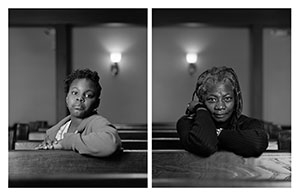By Clair McLafferty
On September 15, 1963, six children’s lives were ended when the Sixteenth Street Baptist Church was bombed. As an eleven-year-old, photographer Dawoud Bey saw images of Sarah Collins, the sister of one of the four little girls. The artist credits these photographs as the inspiration for The Birmingham Project.
Fifty years after this tragedy, Bey’s The Birmingham Project recently opened to the public at the Birmingham Museum of Art. In this exhibit, sixteen diptychs portray Birmingham natives the ages of the bombing’s victims when they died alongside community members who are how old they would be if they were still alive.
For me, the most resonant part of the exhibit was the video component. On the left was footage of four familiar and safe spaces – a barbershop, beauty shop, lunch counter and schoolroom. That footage was juxtaposed with a video of the route from the four girls’ neighborhood to the Baptist church, and closes with a panorama of the church’s façade. This video is shot from a car’s backseat, making it a child’s view of the drive.
The power of this exhibit is in the space between the pieces. Each set of artworks is slightly separated, giving the observer the chance to study each individually, then to pull away and contemplate the meaning of the piece as a whole.
For writers, getting caught up describing the minute details of each artwork in an exhibit can be a major sticking point. However, thorough preparation can be the best remedy for a variety of common mistakes in writing about art.
Read the press releases. Galleries and museums hire many employees with backgrounds in art history. Reading their writing can help you shape yours to describe a certain exhibit.
Search for other articles about the artist. Chances are that you’re not the first to write about this exhibit. Find writers you like and pull out passages you like. These can serve as your inspiration.
Read the artist’s biography. His or her personal background can be used as an interpretive lens for the artworks you’re writing about.
Search the exhibit’s catalog. If someone’s written about the totality of the exhibit, summarizing this information can serve as a great introduction to your article.
Be genuine. If you really and truly don’t know what to say, be genuine. Including a sentence like “Many people may be left speechless by this exhibit. Considering its inspirations, this reaction is not surprising.” Be sure to follow up by documenting who or what moved the artist to create.
Ask for help. Hitting roadblocks is natural, but learning from them or asking for help can teach you new skills, and possibly win you a new editor or mentor. The worst thing that will happen is that you stay stuck.
Don’t be afraid of crappy first drafts. Get it on paper. If it sucks, rewrite it. Repeat until it meets your standards. Then turn it in.
Do you have any other tips on writing about art? Leave them in the comments.
Dawoud Bey’s The Birmingham Project will be on display through Dec. 2, 2013 at The Birmingham Museum of Art, 2000 Rev. Abraham Woods, Jr. Blvd. For more information call 205-254-2565 or visit artsbma.org.
When she isn’t writing, Clair McLafferty can usually be found nerding out on programming, cocktails, physics, comics and movies. Some of these interests spill over into her writing at clairmclafferty.com and on to her Twitter feed @see_clair_write.

Deprecated: parse_str(): Passing null to parameter #1 ($string) of type string is deprecated in /home2/seejanew/public_html/wp-content/plugins/jetpack/class.jetpack.php on line 4073